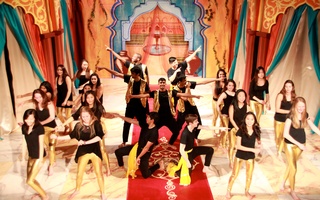Boisterous and serene, traditional and modern, humorous and meditative: Ghungroo 2005 was all of the above, and is definable by their seeming contradiction as well as their interconnectedness. The South Asian Association’s sixteenth annual cultural festival, which took place last week, was a vibrant celebration of both diversity and unification.
The sheer diversity of the acts on Saturday afternoon embodied what Ghungroo is all about, and this diversity also shed some light on the traditions and current trends of the culture that tied the festival together. Ranging from dance and music to poetry and comedy, the acts spanned a broad spectrum of cultures and movements from the Indian subcontinent and diaspora, and made a lovely juxtaposition of the ancient and the modern. The skits that ran in between acts, while partly existing to allow time to set up equipment behind the curtain, served an important purpose in themselves by using humor to showcase the experience of being young and Indian-American in the modern world.
“Ghungroo” itself is the name for sets of bells worn on the ankles in traditional Indian dance, and thus it was appropriate that this instrument be featured in the first act of the show, a classical dance called “Arabhimaanam.” Accompanied by traditional vocal and instrumental music, the dance combined storytelling with graceful dancing, and served to open the audience up to the heritage of Indian dance, essentially providing a background with which to judge all that would follow.
The beautiful contrast and diversity that would characterize all of Ghungroo, and, through it, modern South-Asian culture and society, was established immediately, as the act following this ancient dance form was the much more modern “Chutney-Soca Dance.” The beat of the song, as well as the contemporary wardrobe of the dancers, clearly separated it from the previous act, and the obvious African influence established it as a fusion of cultures, and thus as an excellent representation of the theme of the festival.
The humor employed in the interacts, as well as the two-part skit “The Apprentice in Bombay,” a parody of Donald Trump’s famous (or infamous) television series, provided a fresh perspective on Indian and Indian-American culture, serving up insight as well as laughter. “The Apprentice in Bombay” pitted a team of Indians against a team of Indian-Americans in a battle for Trump’s affection, and jokes and jabs were served up equally against both teams, along with a number against Trump himself. The extreme nature of both teams served to highlight quirks and idiosyncrasies in both cultures, while Trump’s bumbling and stereotyping of the team members pointed out misconceptions on the part of other Americans.
The show wasn’t all laughter and vibrant music, however, as more subdued acts approached some cultural aspects more seriously. Two poems were read, one in each act, each by a lone student in the middle of the dark stage. Both pieces dealt with serious issues: the first, entitled “Kaash Mein Tumhe Roki Hoti” and written by Ravi P. Agrawal ’05, told the tale of the violent cost of revolution from the perspective of a wife after witnessing her husband brutally die for the Communist cause. Such sobering moments offset the more humorous scenes perfectly, and the audience responding as appreciatively to the maudlin as to the merry.
The directors of the show, Bianca K. Mahmood ’06 and Vasanthi G. Reddy ’06, did a good job of offsetting classical and modern acts, maintaining the audience’s interest by constantly switching dynamics. As it was appropriate to begin the show with bells and classical dance, so it made sense to conclude it with Bhangra, a Punjabi dance style that is undoubtedly the most popular crossover style today. The lively performance featured a number of songs commonly heard at recent parties, and the dance showcased the moves and hip-hop influence that have helped to make it so popular.
Overall, Ghungroo accomplished exactly what it set out to do: by contrasting the modern with the ancient, while revealing the common ground that binds them together, it effectively revealed the complexity that dominates the culture and psyche of the modern South Asia. The juxtaposition of styles and influences made clear how important a period this is for the Subcontinent, as young generations with new styles and ways of thinking grow up in a world of ancient traditions and heritage. Approached with humor and solemnity, music and dance, the beautiful complexity was revealed in full, and the largely Caucasian audience couldn’t help but be awed at the vast depth of a region and history they probably, until now, knew little about.
Read more in News
ARTS MONDAY: Jackiw’s Violin Steals ShowRecommended Articles
-
South Asian Dance Show Dazzles LowellTwelve students crisscrossed the Indian subcontinent Friday night, as they turned a well-attended Lowell Lecture Hall into a showcase of
-
Cheers Resound for Performers at Apollo NightHundreds of students and parents braved rain and snow to queue up outside the packed Lowell Lecture Hall on Saturday
-
 Indian Heroine Drama Impresses
Indian Heroine Drama Impresses -
Dance, Glitter Shine in 'Ghungroo'The 18th annual “Ghungroo” was a riot of color, sound, and motion. The Harvard South Asian Association’s three-hour cultural celebration,
-
 Ghungroo 2015 Celebrates Diversity, Inclusivity
Ghungroo 2015 Celebrates Diversity, Inclusivity













